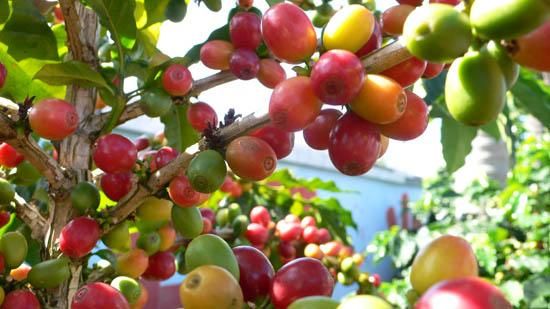Chinese Coffee Market and the Price of Yunnan Coffee planting Coffee Tree Yunnan Coffee
By observing Crema, we can judge the freshness of coffee beans, the completeness of coffee extraction and the uniformity of coffee extraction.
How to tell if the coffee beans are fresh: although you can tell that the beans are fresh when you observe a lot of foam, there is also a possibility that Robusta is high. So we can observe the state of foam precipitation instead. If it is very fresh, the whole process of bean extraction will take the form of crema, and when these crema settle down, they will be clearly divided into two layers. If it is a long-term bean, you will see that there is not much concentrated foam coming out of the shunt nozzle during extraction, usually this cup is thin and watery, and the crema will soon dissipate.
How to judge whether the extraction is complete: the darker the color of crema, the more dissolved substances are extracted.
How to judge whether the extraction is uniform: if the crema is stable, the concentrated color is beautiful and the texture is thick, which means that the channels and depressions in the extraction process are less likely to occur.
Coffee in the world, let's talk about Chinese coffee first. According to the above definition, although China is vast in territory and rich in resources, there are not many places where coffee can be grown. Apart from Hainan and Taiwan, parts of Yunnan, Guangdong and Guangdong, and the southern mountains of Fujian, what's more, agriculture is also a habit, so there is no soil for coffee in the land under the small-scale peasant economy. Although there are a lot of publicity materials about how much coffee is grown and how much coffee is produced in that place. Strictly speaking, the domestic coffee industry is almost as blank as it can be.
When it comes to Chinese coffee, we must first talk about Yunnan coffee. Overseas coffee development has experienced three waves of instant coffee in World War II, Starbucks and boutique coffee, while the development of coffee in China has experienced four waves.
Coffee in Yunnan began in 1892. French priest Tian de wanted to drink coffee but could not get it, so he brought some coffee seeds to the church of Zhukula Village Committee in Pingchuan Town, Dali, and began to grow the first coffee in China. Unfortunately, due to the inconvenient transportation, the coffee did not flow to more places, fortunately, because of the inconvenient transportation. After more than a hundred years, more than 1000 bourbon and Tibica have been handed down. Two years ago, I heard that people in the coffee industry are going to make a pilgrimage. Zhukula Village has been growing and grinding itself for a hundred years, and it should also be the dream of young people on the Bund in Shanghai after they have made money. It is not surprising that there is coffee but it is not popular in Yunnan.
Then, after a few decades, in the middle and later stages of the Anti-Japanese War, Yunnan became the rear area. A large number of rich overseas Chinese from Nanyang came to Yunnan with their anti-Japanese ideals and coffee, and went to coffee shops after production. I don't know which Wen Qing even wrote a word to the beautiful boss of the Vietnamese shop, "sad words of the old country, lazy makeup in southern Xinjiang, eyebrows and tears turning to the vicissitudes of the world, speechless." The coffee culture of this department is a little special, that is, when you stir-fry coffee, you add something else, such as cream (followed by a branch of white coffee. The overseas Chinese in Malaysia are idealists. If they have some money, they have to do something for this country, otherwise they will feel sorry for their ancestors. Later, in the early 1950s, this group of idealists went to Hainan, another coffee-producing place in China, to prosper, because Zhou Enlai said that the coffee in this place was better than that in other places, deceiving Hainan people into growing coffee for decades. Anyway, although the result is not good, at least this stage let the Chinese know that we can actually grow coffee.
Ten years ago, people began to call Yunnan coffee small grains of coffee. This Arabica hybrid named Katim was first introduced to China by Nestl é. Katim is not a variety with obvious style. Nestl é sells goods that are not special, so Katim, which has good resistance to rust and does not taste good, has been vigorously promoted in Yunnan. Yunnan's coffee price is still subject to Nestle's orders. On the other side of the Pacific Ocean, the same coffee variety has been promoted and named Colombia. Coffee trees all over the world are sick, but Colombia has become the second largest coffee industry in the world with this variety alone. It is said that the same people have different lives. It turns out that the same tree can also have different lives. Yunnan, Hainan and Vietnam are still growing coffee at the stage of reflection in the old era. Another branch of the story is that the Taiwanese introduced the same species of Yunnan to Alishan and worked hard for several years. Last year, they won awards every year in the test of boutique coffee cups, and last year they were the eighth in the world and the top in Asia.
When coffee is the same all over the world, you need to find something different.

Important Notice :
前街咖啡 FrontStreet Coffee has moved to new addredd:
FrontStreet Coffee Address: 315,Donghua East Road,GuangZhou
Tel:020 38364473
- Prev

The darker the color of crema, the darker the espresso, how to drink the delicious concentrated beans.
Tiger spots usually understand that crema is a concentrated surface with some dark brown tiger spots, which Dr Illy adds to his definition of concentration. Tiger spots are tiny fragments of coffee powder that are pushed out of coffee pressed powder during extraction. We usually see the tiger spot first appeared in the edge of the concentrated cup, and gradually distributed to the whole concentration over time.
- Next

Correct storage of coffee beans and purchase of high-quality coffee coffee roasted Italian mixed beans
By observing Crema, we can judge the freshness of coffee beans, the completeness of coffee extraction and the uniformity of coffee extraction. How to tell if the coffee beans are fresh: although you can tell that the beans are fresh when you observe a lot of foam, there is also a possibility that Robusta is high. So we can observe the state of foam precipitation instead. If they are very fresh beans
Related
- Beginners will see the "Coffee pull flower" guide!
- What is the difference between ice blog purified milk and ordinary milk coffee?
- Why is the Philippines the largest producer of crops in Liberia?
- For coffee extraction, should the fine powder be retained?
- How does extracted espresso fill pressed powder? How much strength does it take to press the powder?
- How to make jasmine cold extract coffee? Is the jasmine + latte good?
- Will this little toy really make the coffee taste better? How does Lily Drip affect coffee extraction?
- Will the action of slapping the filter cup also affect coffee extraction?
- What's the difference between powder-to-water ratio and powder-to-liquid ratio?
- What is the Ethiopian local species? What does it have to do with Heirloom native species?

